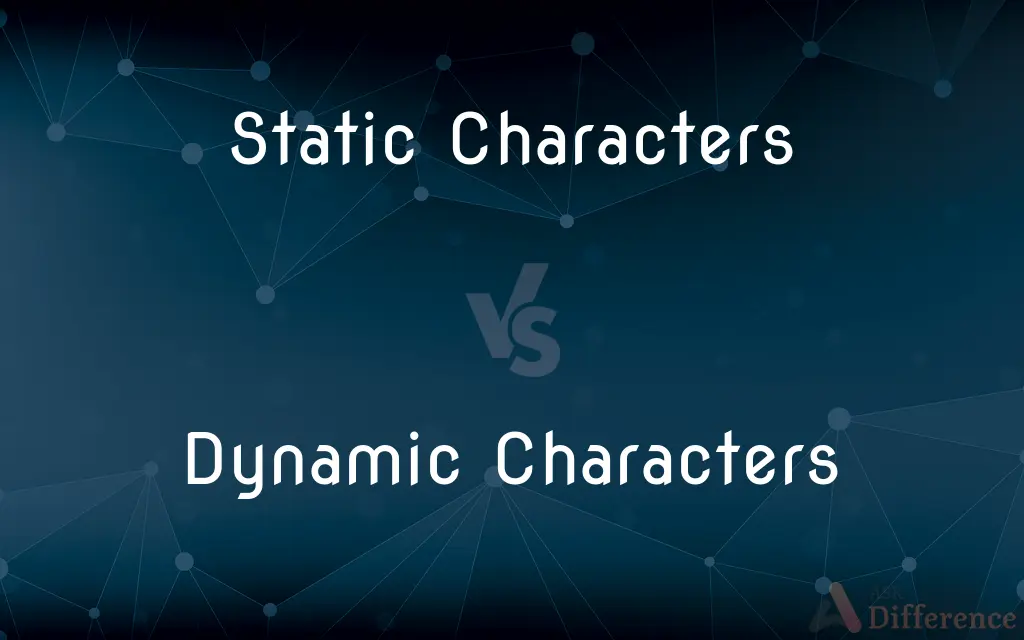Static Characters vs. Dynamic Characters — What's the Difference?
Edited by Tayyaba Rehman — By Fiza Rafique — Published on December 29, 2023
Static Characters remain unchanged throughout a story, while Dynamic Characters undergo significant development or change.

Difference Between Static Characters and Dynamic Characters
Table of Contents
ADVERTISEMENT
Key Differences
In literature, Static Characters are those who remain consistent in their beliefs, personality, and relationships from the beginning to the end of a story. Conversely, Dynamic Characters display notable growth, evolution, or transformation as the plot unfolds.
Static Characters serve as constants, providing a stable backdrop against which the changes in other characters can be highlighted. In contrast, Dynamic Characters often lie at the heart of a story's theme, as their development or transformation often mirrors the narrative's central message.
Often, authors use Static Characters to emphasize particular traits or moral standings that need to remain constant throughout the story. On the other hand, Dynamic Characters are instrumental in showcasing the effects of experiences, decisions, or personal reflections.
While Static Characters can be central to a story, their lack of change doesn't mean they're dull or unimportant. In contrast, Dynamic Characters, with their evolving nature, often undergo challenges and dilemmas, making them central to the story's emotional depth.
Both Static Characters and Dynamic Characters have their places in literature. The former offers reliability, and the latter offers growth, and a combination of both can create a balanced and compelling narrative.
ADVERTISEMENT
Comparison Chart
Development
Remain consistent throughout
Undergo significant changes
Role in Story
Offer stability and consistency
Drive the story with their evolution
Reflective of
Fixed traits or beliefs
Personal growth, experiences, and transformation
Impact on Plot
Might not influence the main plot progression
Often central to the story's main developments
Relation to Theme
Can emphasize unwavering moral or beliefs
Showcase the narrative's central message through change
Compare with Definitions
Static Characters
Characters who maintain a consistent nature throughout a narrative.
Mrs. Bennett in Pride and Prejudice remains consistently concerned about her daughters' marriages, making her one of the Static Characters.
Dynamic Characters
Evolving personalities in literature.
Harry Potter, from a naive boy to a brave young man, embodies the essence of a Dynamic Character.
Static Characters
Individuals in a story who don't experience significant transformations.
Despite the chaos around him, Bob in the novel stayed true to his principles, showcasing his role as a Static Character.
Dynamic Characters
Characters deeply affected and changed by the story's events.
Frodo Baggins, after his perilous journey in The Lord of the Rings, returns as a changed Dynamic Character.
Static Characters
Figures whose core beliefs or personalities remain unaltered.
Sherlock Holmes, with his brilliant deductive skills and peculiar habits, is a classic example of a Static Character.
Dynamic Characters
Figures who adapt, grow, or transform due to events or experiences.
Simba in The Lion King evolves from a carefree cub to a responsible king, highlighting his journey as a Dynamic Character.
Static Characters
Unchanging personalities in literature.
Even after witnessing multiple adventures, Watson in Sherlock Holmes stories remains a loyal and grounded Static Character.
Dynamic Characters
Individuals in a story who evolve in beliefs, personality, or relationships.
Over the course of the novel, Jane's experiences shape her into a strong, independent woman, making her a Dynamic Character.
Static Characters
Characters unaffected by the major events of a story.
In many fairy tales, the evil stepmother remains wicked from start to finish, positioning her as a Static Character.
Dynamic Characters
Characters who undergo significant change throughout a narrative.
Ebenezer Scrooge's transformation in A Christmas Carol showcases him as one of literature's iconic Dynamic Characters.
Common Curiosities
What defines Dynamic Characters?
Dynamic Characters undergo notable growth, change, or transformation as a narrative progresses.
Can Static Characters be protagonists?
Yes, Static Characters can be central figures, but their traits and beliefs remain consistent.
Why are Dynamic Characters important?
Dynamic Characters often drive a story's emotional depth and theme through their personal evolution.
Do all stories have Dynamic Characters?
Not necessarily. Some narratives focus on situations rather than character development.
Can a character start as static and become dynamic?
Yes, some characters might appear static initially but evolve into dynamic ones as the story unfolds.
Do Static Characters contribute to a story's depth?
Absolutely. They provide a stable backdrop against which changes in other characters or events can be highlighted.
Are Dynamic Characters always likable?
Not always. Their transformation might not always be positive or appealing.
Do Dynamic Characters always end positively?
No, their transformations can lead to both positive and negative outcomes.
What are Static Characters?
Static Characters maintain their traits, beliefs, and relationships consistently throughout a story.
How do authors showcase a Dynamic Character's evolution?
Through experiences, challenges, internal reflections, relationships, and decisions.
Can one story have both Static and Dynamic Characters?
Yes, many stories blend both types to create a balanced narrative.
Are Static Characters always secondary?
No, Static Characters can be main or secondary figures; their defining trait is consistency.
Are Static Characters predictable?
While they remain consistent, they can still have complex personalities and aren't necessarily predictable.
Share Your Discovery

Previous Comparison
5w20 vs. 5w30
Next Comparison
Job vs. UndertakingAuthor Spotlight
Written by
Fiza RafiqueFiza Rafique is a skilled content writer at AskDifference.com, where she meticulously refines and enhances written pieces. Drawing from her vast editorial expertise, Fiza ensures clarity, accuracy, and precision in every article. Passionate about language, she continually seeks to elevate the quality of content for readers worldwide.
Edited by
Tayyaba RehmanTayyaba Rehman is a distinguished writer, currently serving as a primary contributor to askdifference.com. As a researcher in semantics and etymology, Tayyaba's passion for the complexity of languages and their distinctions has found a perfect home on the platform. Tayyaba delves into the intricacies of language, distinguishing between commonly confused words and phrases, thereby providing clarity for readers worldwide.












































